|
Where next after Venice, and Florence? Trips to Padua and Verona (both cities which came under Venetian rule in the fifteenth century) suggested that they were more than worthy, and that with works by Bellini, Titian and the Tintorettos in evidence there were going to be plenty of connections, I thought. Well, it didn't quite turn out that way. It turns out that Padua and Verona couldn't provide more different art thrills. Altichiero comes from Verona, but his best stuff is in Padua. Veronese comes from Verona but his best stuff is not there. And Verona's churches are actually chock full of works by artists like Domenico Morone, Girolamo dai Libri, Caroto, Brusasorci and the Badile family - all of them having produced works of high quality and loveliness, and most have the usual quota of brothers, sons and fathers to trip up the unwary. They are also not at all well-covered in the literature - none of them have the plush and comprehensive monographs that one might expect, and desire. Both cities also have more tastefully-crumbling ancient remains and tastefully-faded pre-Renaissance frescos than Venice. What's not to love and want to visit and photograph, and write about?
These six churches are the best, I think, and
so now have pages to themselves. |
|
Padre Filippini San Fermo Minore di BrÓ Via Filippini |
||
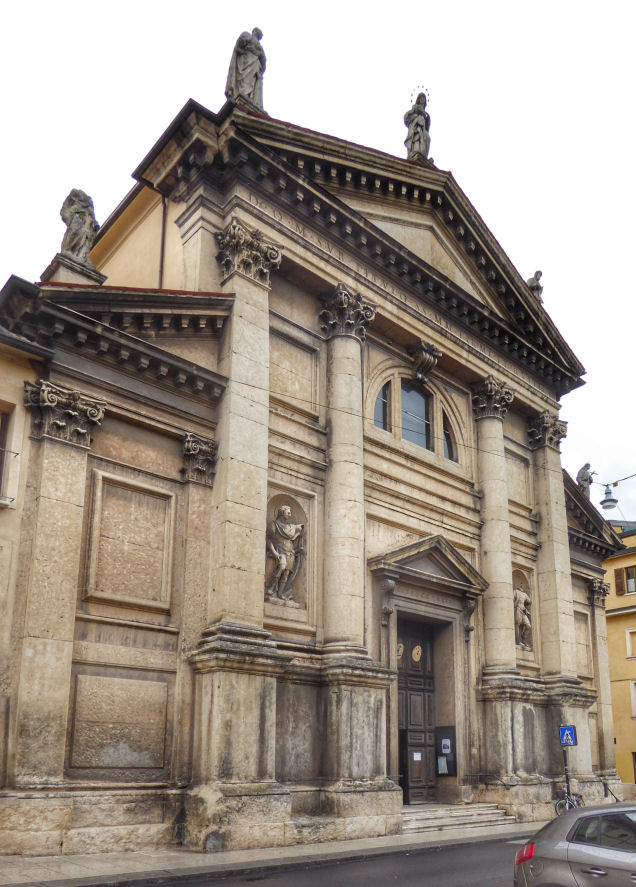  History Dedicated to the Saints Fermo and Rustico. Built from 1746, to designs by Andrea Camerata, by the Oratorians, who had found their previous church, San Fermo Minore, to be becoming too small. Finished by 1791 and decorated with works from the destroyed San Fermo Minore. The church was heavily damaged during the Second World War and subsequently rebuilt.
|
||
|
|
||
|
This church has its own page |
||
|
San Domenico Via del Pontiere |
||
|
History A church and monastery was built here on land bought in 1517 for Dominican nuns whose complex outside Verona, San Domenico dell'Acqua Traversa, had been demolished because the Republic of Venice's insistence on the clearing of land a mile around the city walls for ease of defence. The major work took place between 1537 and 1543. The nuns moved in in 1543 and the church was consecrated on November 11th 1554 by the bishop of Verona Luigi Lippomano. The church was rebuilt at the turn of the 17th and 18th centuries with the loss of the 16th century fittings. Suppressed by Napoleon in 1811 the complex passed into private hands. Initially bought by Domenico Maboni, it was later, between 1827 and 1831, bought from him by Leopoldina Naudet, founder of the congregation of the Sisters of the Holy Family. It then passed to the Municipality of Verona who split it up and put it to various uses including a technical institute, the HQ of the fire brigade first, and then of the police. The complex suffered significant damage during World War II with only the church and cloister remaining. The church looks pretty derelict but has been used by Evangelical Lutherans since October 3rd 2010. The church seems to have recently become known as San Domenico al Corso and put to cultural uses. Exterior The grand stone portal to the street was built during the 17th/18th century renovations. The statue in the niche is Saint Dominic by Orazio Marinati. Interior Very baroque and colourful, with much painting and marble. Altars built by Francesco Marchesini during the same rebuilding work. The vault frescoes feature Dominican subjects by Francesco Marchesini's son, Alessandro, centred on The Glory of Saint Domenic, with trompe l'oeil architecture by Antonio Zanoni. Other artists with work here include the French painter Ludovico Dorigny, Sante Prunati and his son Michelangelo, Simone Brentana and Odoardo Perini. 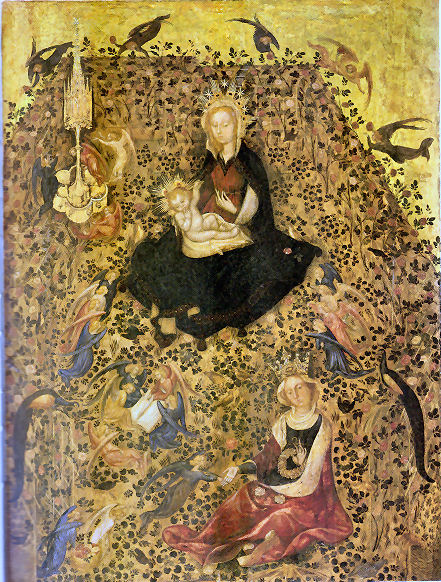 Lost art The Castelvecchio's justly famous and luminous Virgin and Child with Saint Catherine, called the Madonna of the Rose Garden (see right) of c.1420ľ1435, which has been attributed most recently to Michelino da Besozzo and previously to Stefano da Verona. Crowe and Cavalcaselle (in A History of Painting in North Italy) thought that it was by Pisanello. But it should be noted that the painting includes a peacock which was, according to Vasari, Stefano da Verona's hallmark (contrassegno). The Miracle of San Domenico (The Healing of Napoleon Orsini Fallen from his horse) by Antonio Balestra is also now in the Castelvecchio Museum. Opening times A fresh sign with the name and logo of the Sorelle della Sacra Famiglia on it says Monday, Wednesday and Friday 8.30-1.30 But this was on San Domenico's Facebook page which hasn't been updated since December 2021, so caution is advised. |
|
|
|
This church has its own page |
||
|
San Giacomo alla Pigna Via San Giacomo alla Pigna |
||
|
Lost art A triptych showing the Virgin and Child Enthroned flanked by Saints Peter and James by the studio of Antonio Badille II, once over the high altar here, is in the Castelvecchio, where it's been since 1812. As has a Virgin and Child with Saints Roch and Sebastian by Girolamo Dai Libri, called The Mafffei Madonna. |
|
|
|
San Giorgio in Braida Piazzetta San Giorgio |
||
|
History A church was first built here in the late 8th century, in a field by the walls, hence Braida from the Germanic breit meaning a large clearing. The current church was built from 1477 to designs by Antonio Ricci. This building was begun by wealthy Venetian monks, the Canons Regular from San Giorgio in Alga, who acquired the monastery complex from the Benedictines in 1442. In the mid-16th-century the Venetian mannerist architect Michele Sanmicheli added a rare-for-Verona dome. He also designed the campanile, actually executed by Bernardino Brugnoli, who never finished it, and the gate. The facade was begun later in the 16th century but only finished in the 17th, with the statues of the Saints George and Lorenzo Giustiniani added in the 18th century. Interior A somewhat stern and bare aisleless nave with four deepish chapels each side and a dome over the crossing, all the work of Sanmicheli from 1536-43. An organ and choir gallery take the place of transept arms, both supported by four columns. The deep apse has Paolo Veronese's fine much-removed, -damaged and -restored Martyrdom of Saint George over the high altar, painted in 1566, the same year that he was in Verona to 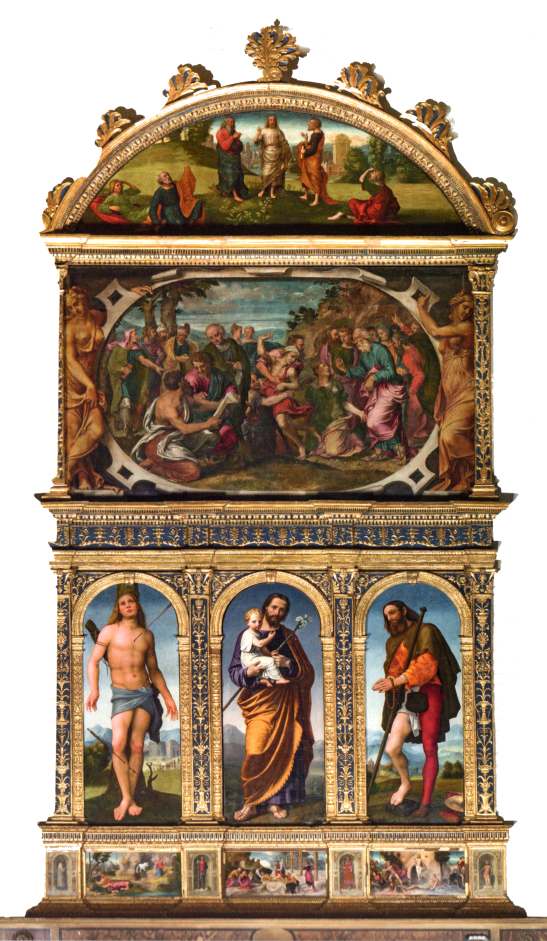 marry Elena Badile. The altar itself was
designed by Bernardino Brugnoli, a nephew of Sanmicheli, although some
sources attribute it to Sanmicheli himself. On the left of the apse
is Manna by Felice Brusasorci, on the right The Multiplication
of the Loaves is a late work by by Paolo Farinati. Both are a bit forgettable and were
completed by the pupils Alessandro Turchi and Pasquale Ottino. Either side
of the arch is a pair of canvases, once organ shutters, of the Annunciation
by Giovanni Caroto from c.1508,
he being the younger brother of the more famous Giovan Francesco. marry Elena Badile. The altar itself was
designed by Bernardino Brugnoli, a nephew of Sanmicheli, although some
sources attribute it to Sanmicheli himself. On the left of the apse
is Manna by Felice Brusasorci, on the right The Multiplication
of the Loaves is a late work by by Paolo Farinati. Both are a bit forgettable and were
completed by the pupils Alessandro Turchi and Pasquale Ottino. Either side
of the arch is a pair of canvases, once organ shutters, of the Annunciation
by Giovanni Caroto from c.1508,
he being the younger brother of the more famous Giovan Francesco.Some very fine altarpieces in the nave, though, once admired by Goethe and lit by red buttons by the label stands. The first chapel on the left has Saint Ursula and the 11 Thousand Virgins (1545) by Giovan Francesco Caroto, the second has a Martyrdom of Saint Lawrence (1583) by Sigismono de Stefani. The polyptych in the third (see right) is from c.1510/15 with admirable paintings of the plague saints Roch and Sebastian by Giovan Battista Caroto. The soppy central panel of Saint Joseph and the Christ Child (1882) is by someone named Recchia and covers a fresco of the 14th century of Christ Carrying the Cross which was said to have miraculous powers but had become damaged. There's a crowning lunette panel of The Transfiguration and a large later (1545) oval painting of Apostles Trying to Exorcise a Demon from a Possessed Boy by Domenico Brusasorci, a pupil of Caroto. The wide predella panels, by Caroto, depict The Agony in the Garden, The Deposition and The Resurrection, with the pilasters between these panels having figures important to the Canons Regular. A highlight is the Virgin and Child Enthroned between Saints Zeno and Lorenzo Giustiniani of 1526 in the next one (also known as the Madonna della Cintura) (see below right), by Girolamo dai Libri, which is decidedly Bellini-ish with another Domenico Brusasorci lunette above, this time of God the Father. Above the main door is a an unusually simple and orangey Baptism of Christ by Tintoretto. There's also a Pentecost by Domenico Tintoretto, his son, over the third altar on the right. A Virgin with the Three Archangels and Tobias by Felice Brusasorci is in the next one. Lost art An enormous stage-set-like Crucifixion of 1501 painted for the refectory here by Michele da Verona is now in the Brera. The coat of arms at upper right suggests that it was commissioned by Niccol˛ Orsini. A smaller version, dated 28th March 1505, was painted for the church of Santa Maria in Vanzo in Verona, both being commissioned by the Secular Canons of the Blessed Lorenzo Giustiniani. Paolo Veroneseĺs Miracle of Saint Barnabas is a rare depiction of a narrative of this apostle, showing him healing the sick in Cyprus by touching them with a book of the Gospel of Saint Matthew. This altarpiece was looted from this church by the French in 1797, as was his Martyrdom of Saint George. The Saint George was returned in 1815 but Saint Barnabas was not and is now in a gallery in Rouen. There's a copy here under the choir gallery. Nearby shrapnel The 1791 rectory attached to the church still has bullet holes from October 1805 from the fighting between the French and Austrian troops occupying opposite banks of the Adige. Opening times A group called Verona Minor Hierusalem staffs touristic visit times for this church, and four more nearby. The times they publicise for this church are Thursday, Friday, Saturday 10.00 - 5.30 Sunday 1.00 - 5.30 I assume that the church will be open at other times too. |
|
|
|
The church in the 19th century. |
||
|
|
|
|
|
|
||
|
History Founded in the 8th century, with some conjecture taking the date of building back to the 4th century, the original church was built on the site of an ancient pagan cemetery and a Roman temple. Remains of this first church survive as part of the current crypt. Rebuilding after destruction during the 1117 earthquake resulted it the current Romanesque church, consecrated by Ognibene, the bishop of Verona, in 1164. The fašade was originally where the first pair of pilasters are now, but it was rebuilt one bay to the west. as can be seen by the wall surface, in the 14th century, after the Council of Trent, to make an area for the unbaptised. Badly bombed in 1944, on the night of the 10th of October, by a direct hit to the nave, damaging the church's 13th and 14th century frescos and killing and injuring people sheltering in the crypt. Restoration work followed, with the opportunity taken to restore the small windows in Romanesque style and remove the larger 17th century windows. The 15th century front doorway and porch has The Virgin and Child with Saints Bartholomew and Anthony Abbot, a fresco by Stefano da Zevio in the lunette. Interior A long tall narrow nave on two levels with two aisles divided by slim marble columns alternating with stout pilasters. The floor is 19th century. The raised presbytery sits over the crypt and originally had no staircases, being a separate area for the high timber ceiling with a considerable exposed brick and a pale stone. A clerestory level with three small windows one side and some fresco bits on the other. Later decoration in the last two pairs of arches before altar. Layers of early fresco which evidently appeared from under whitewash in late 19th/early 20th century on the right wall of the raised presbytery area, the oldest looking very Byzantine (see photo below). The walls here would have once been entirely covered in frescoes. 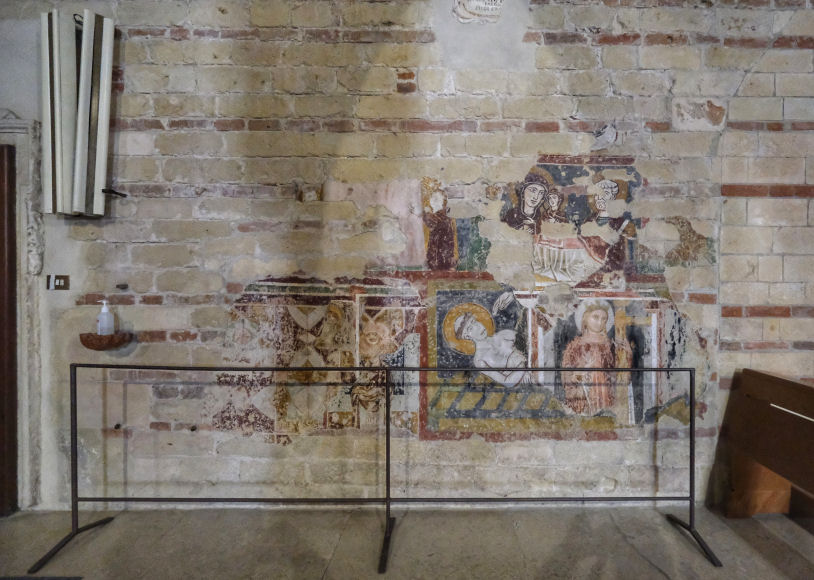  The crypt The cryptTo be found under the raised presbytery. The remains of the 9th century church are towards the front, with the rear in Romanesque style and dating to the 12th. Damaged frescoes on the right wall. The polychrome marble altar is 16th-century. Also down here are a pair of early Christian sarcophagi, probably from the cemetery the church was built upon. The one on the left (see photo right) is 4th century and said to contain the relics of Saints Jude and Simon and has carved reliefs on three sides with stories from the Old and New Testaments, in the upper and lower registers respectively. The lid, sloping with Saints Simon and Judas depicted is not original but was installed in 1395 with the claimed discovery of the relics of the two saints. The other is 2nd or 3rd century, may be Roman, and has busts of a husband and wife in a shell in the centre as well as figures of philosophers at the corners later transformed into Saints Peter and Paul. Fragmentary frescos in the chapels down here too. Campanile Romanesque below, with Roman stones used, and renaissance above, with mullioned windows. Five bells by Cavadini from the 19th century. Cloister Romanesque. Only one wing remains (see photo below) with the rectory in the courtyard, also very old, probably contemporary with the church. Local artist The first record of the life of Liberale da Verona is in the census of 1455 for the neighbourhood of this church.
Opening times |
|
|
| San Girolamo | ||
|
History In the Roman Theatre complex, now part of the Archaeological Museum, along with the complex's refectory (where fragments of fresco remain) and cloisters. built by the Jesuits in 1492. Following a series of sales, the building came to one Giovanni Bertani, who rebuilt it in 1838 in its present form. Interior A small church with a ceiling of painted wooden panels, now used to display patches of mosaic flooring as part of the Museo Archeologico al Teatro Romano. Art The Annunciation fresco over the apse arch is an early work by Giovan Francesco Caroto, signed and dated 1508. They were painted after he had spent some time in Milan, which may explain the Leonardo look to them. In the underside of the apse arch, frescoed 1465 under Domenico Morone's direction, the Four Evangelists are 'obviously by the hand of Liberale da Verona' Inside the apse are four lunettes and a window - Christ is flanked by Saint Peter and Saint Paul, and to the right is Saint Jerome. Over the altar is a panel depicting Saint Jerome of 1578 by Paolo Farinati.
|
|
|
|
History The original Roman basilica on this site (supposedly dedicated to Venus) was built in the 5th century and restored in the late 8th. The current church was built around 1110, and it is suggested that Lanfranc of Modena, the architect credited with that city's famed cathedral, was responsible. There was more work after 1117, after the earthquake, and considerably enlargement shortly after that. The pre- and post-earthquake phases are visible on the outside as the alternating bands of pebbles with brick and stone in the lower level give way to just bricks and stone above the lower windows. Extensive restoration in 1877 to return it to its former glory.
Exterior
Campanile |
|
|
 |
||
|
San Luca Corso Porta Nuova |
||
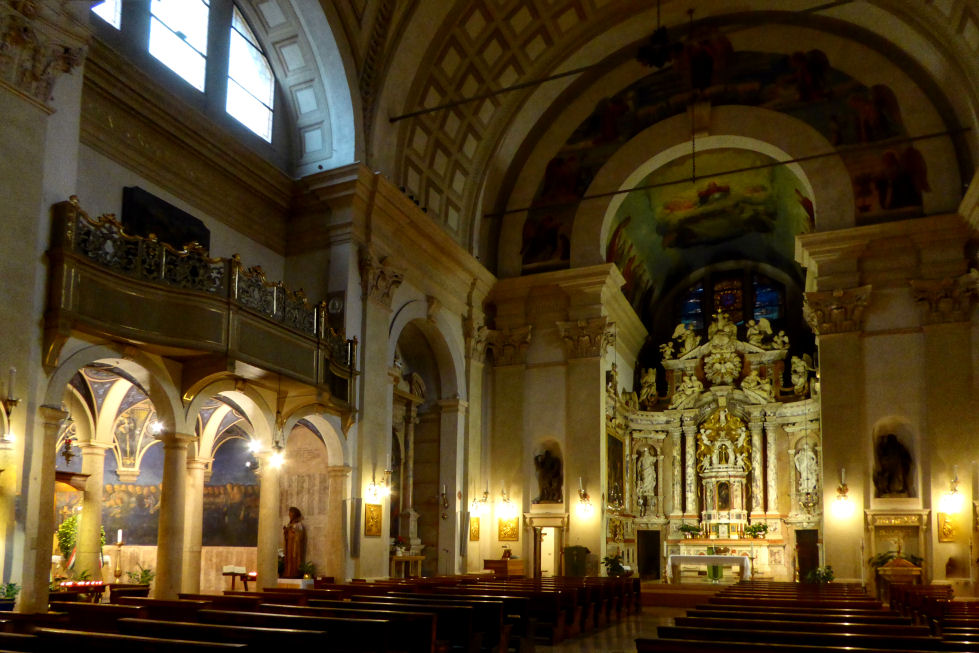 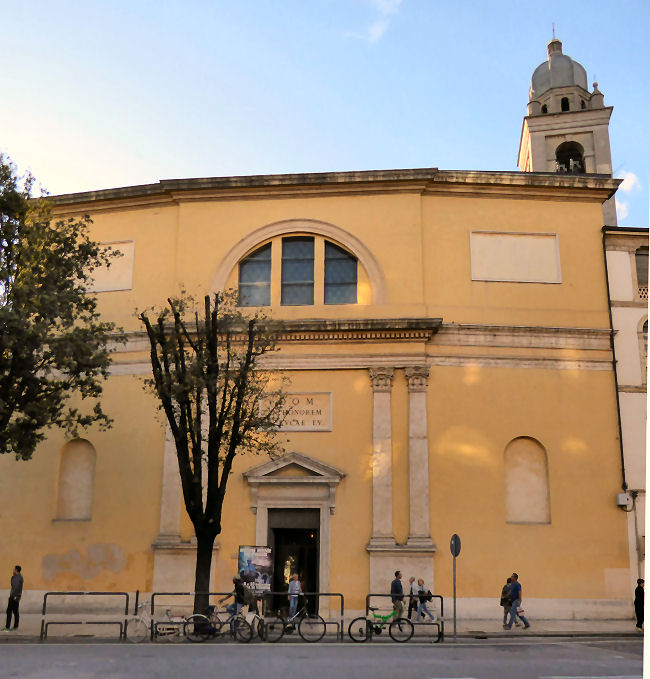 History The original church on this site was built in 1172 by the Cavalieri Crociferi (Knights of the Crucifix). This Order was abolished in 1656 by Pope Alexander III. In March 1657 the church passed to the Compagnia del Santissimo Sacramento (Society of the Most Holy Sacrament). Major rebuilding followed - the fašade in1675 and the high altar in 1691. Expansion from 1753 to reconsecration in 1755. The Compagnia were suppressed by Napoleon in 1807 and in 1808 San Luca became a parish church, appointing San Silvestro and Ognissanti. More work in the 19th century, as a result of road widening, in 1874, the altar dedicated to Saint Luke was demolished . Only the exterior right side of the church is now visible, due to building around the church.
Art Campanile
Opening times
Daily 8.00 - 5.00 |
||
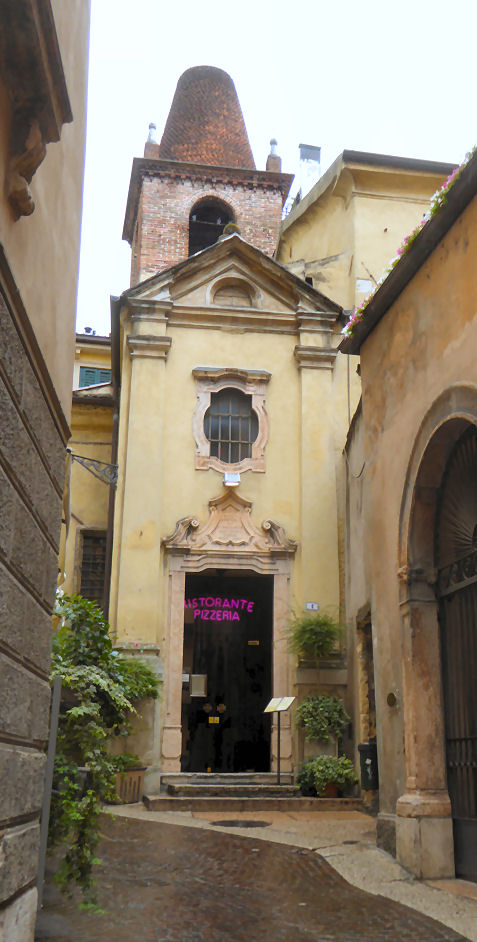 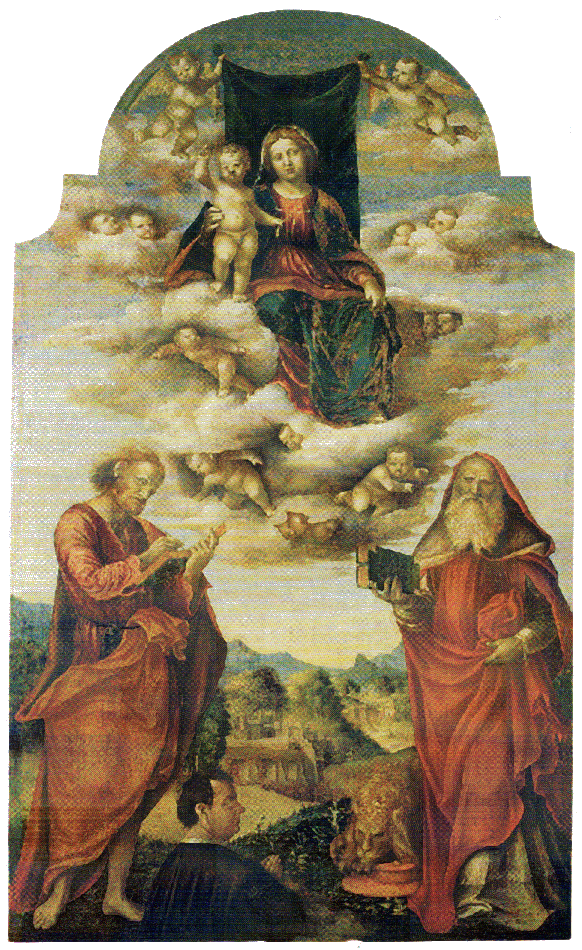 History A church, built over a temple to the Roman god Giano (Janus), was first mentioned in a document of 1105 when part of the church was given to the abbey of Pomposa. Restoration work in the 18th century was followed by suppression in 1860. Used during the WW2 as a military warehouse, laundry and later as a carpenters' workshop. Now a pizza restaurant. Through a glass panel in the floor the remains of the ancient temple of Janus can still be seen. Lost art A panel depicting the Mystic Marriage of Saint Catherine by the Studio of Antonio Badile II and a Virgin and Child in Glory with Saints Matthew and Jerome and a donor, called the Madonna de' Caliari, by Nicola Giolfino (see right), from c. 1530, have both been in the Castelvecchio since 1812. The latter was the high altarpiece and features Jerome in his anachronistic cardinal's red robes and hat, not instigated until 700 years after his death.
|
||
|
The church of San Sebastiano
in 1946 before its fašade was removed and attached to San Nicol˛. |
||
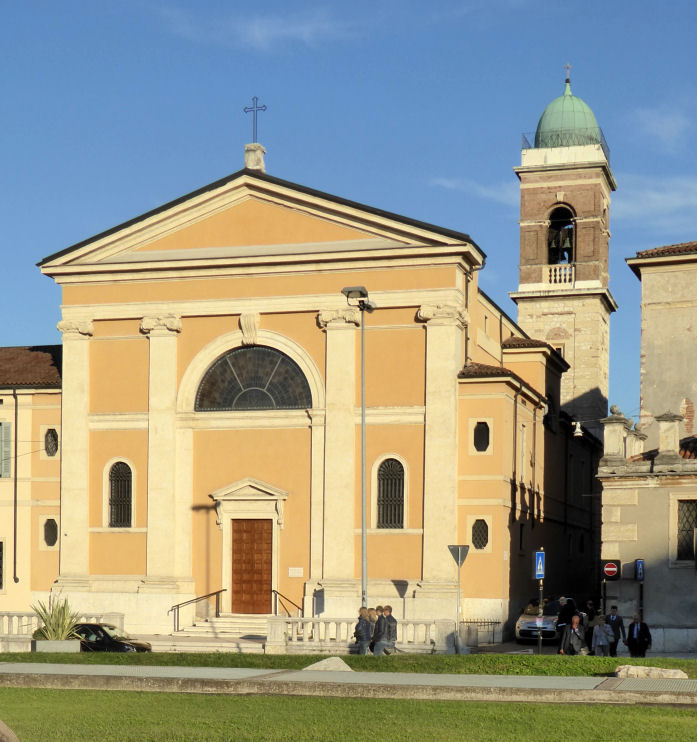 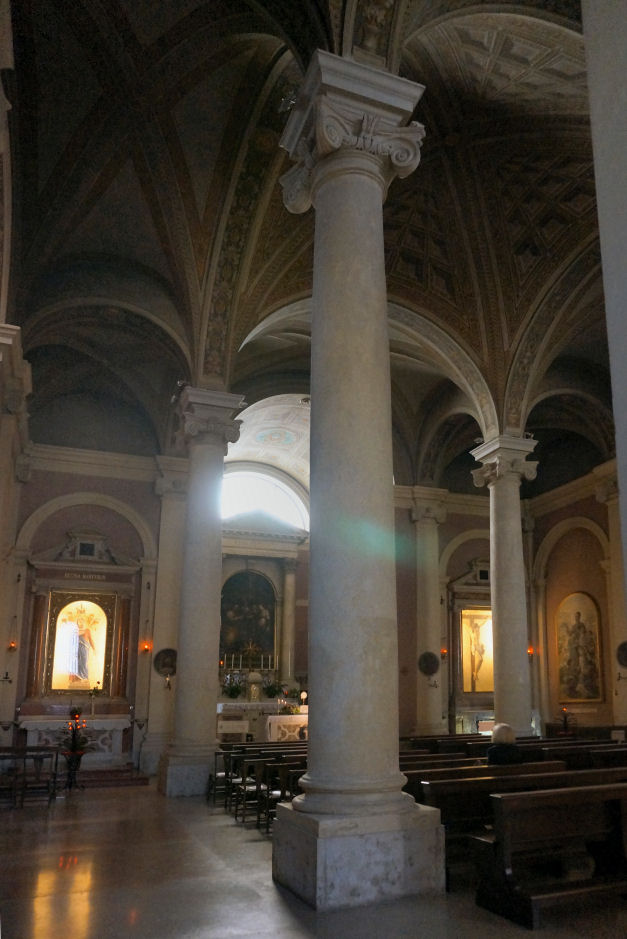 History In 1816, following suppression by Napoleon, the complex (including the old church of San Francesco) was taken over by Gaspar Bertoni, a local priest and (later) saint who was baptised in San Paolo in Campo Marzio (see the entry below). He established a school here and later founded the Congregation of the Sacred Stigmata, later known as the Stigmatines.
Interior
|
||
|
History A Romanesque church dedicated to Saints Peter and Paul was built here in the late 11th century. In 1183 rebuilding began, probably due to damage sustained during the earthquake of January 3, 1117. Run by secular priests until 1232 when it passed to the Order of the Umiliati. More work in 1289, when the Umiliati are thought to have left, during which a campanile was built. Count Alessandro Pompei, an architect and scholar of ancient Veronese art, directed later rebuilding between 1740 and 1768. Gaspar Bertoni was baptised here on October 10th 1777 - he went on to found the Congregation of the Sacred Stigmata (Stigmatines) in Verona (see the entry above) and was canonised in 1989. There is a plaque in the baptistery here celebrating his 200th birthday. On January 4 1945 allied bombing gutted the church, but the most important works of art were saved by having been removed and placed in shelters. The church was rebuilt by 1950, recreating the style of the 18th century rebuilding.
Interior |
|
|
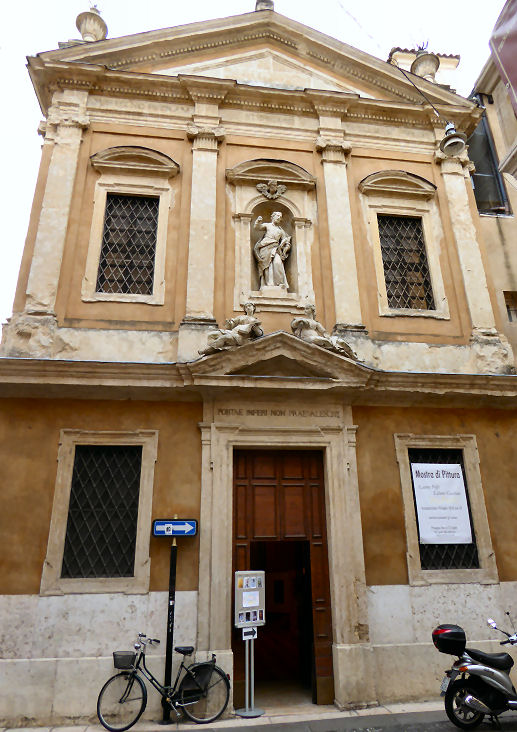 History Was a Benedictine church in 1147. Had/has an Annunciation by Paulo Farinati. Deconsecrated and currently used for art exhibitions. Opening times Wednesday to Sunday 10.00 - 1.00, 3.00 - 7.00 But this may be reliant on an exhibition being on. |
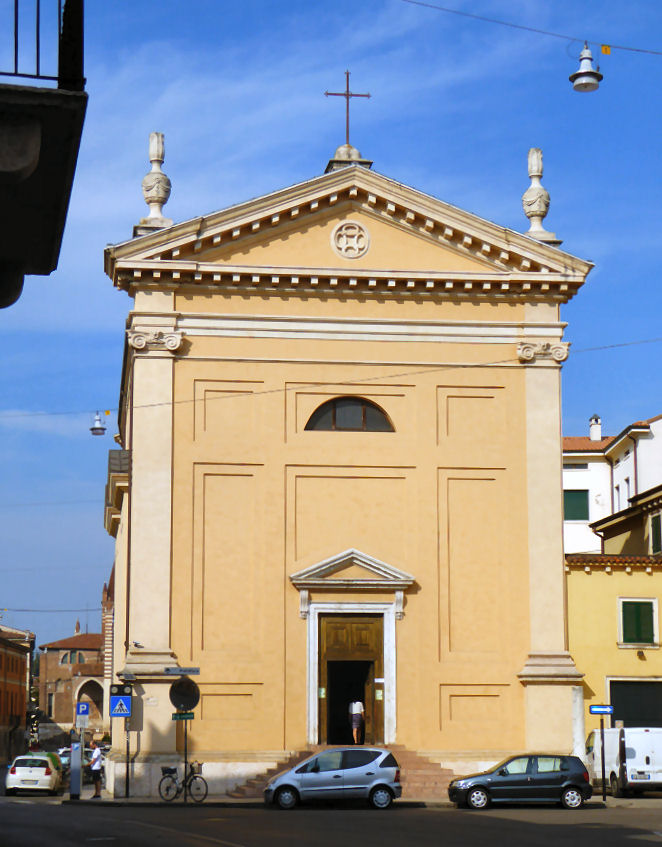 History Founded in the 10th century on the site of a plague pit, hence carnario, by the Marchese Milone, in an area then on the outskirts of the city. The first documented mention is in Milone's will, dated 10th of July 955. Several rebuildings, the last in the 18th century. Following bomb damage during WWII the facade was rebuilt further into the church and two of its six side chapels (damaged by the bombing) were thereby lost. Now used by a Romanian Orthodox congregation. Interior Today it's an aisleless box. The crypt contains remains of the earlier church, including a fresco of the Crucifixion which may date (experts argue) from the 10th or 11th (or 13th) century. Works by Brusasorci? Campanile 14th century 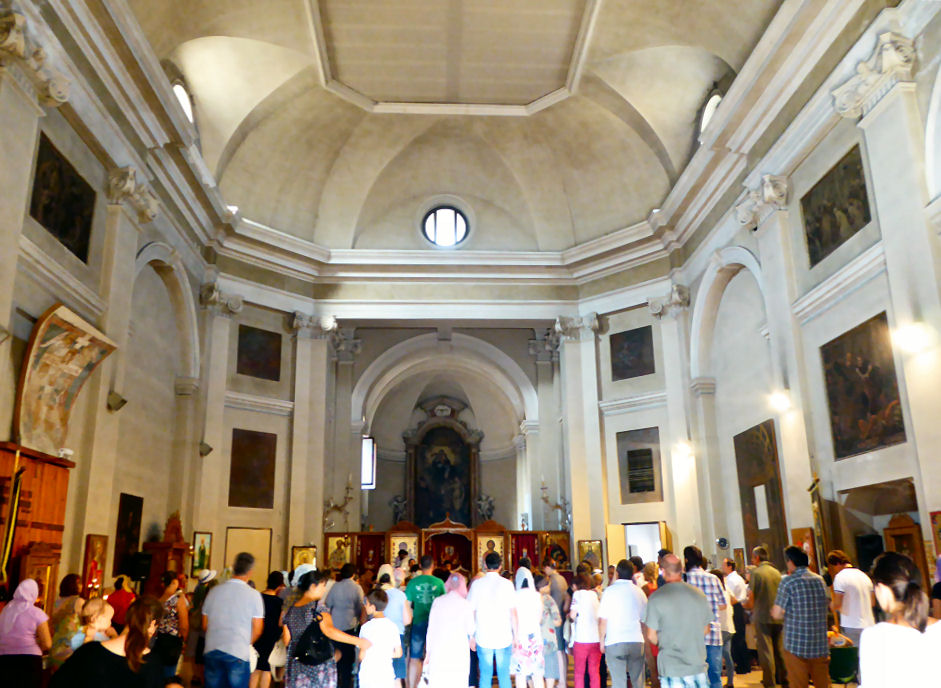
|
|
|
|
|
|
 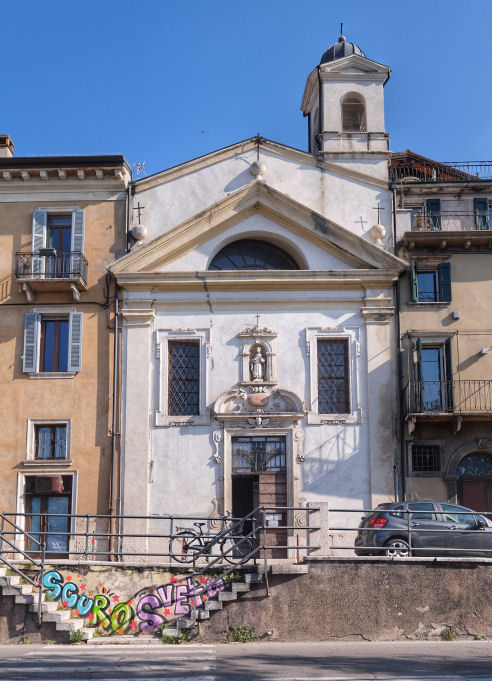 History Bishop Sebastian Pisani on April 28, 1656 blessed the first stone of the church of San Pietro Martire, erected on the ruins of named saint's birthplace A group called Verona Minor Hierusalem now staffs touristic visit times for five churches near this one, with this church being used as their HQ, as you can see in the photo right. Opening times The HQ is advertised as open Thursday to Sunday 9.30 - 6.00 but I advise trying on a Saturday, when I was lucky, as it's their major staffing day, and they seem to be volunteers. |
||
|
The church and attached
Benedictine monastery were suppressed on July 28, 1806, and set for
demolition and/or use as a military warehouse. Knocked about by later
restorations and bombing, the church is now deconsecrated, was used for art exhibitions
for a while, but is now a bank. The adjoining monastery is now luxury
apartments.
|
|
|
|
San Tomaso Cantuariense |
||
|
History The present church was built in the 15th century by Carmelites to replace two earlier churches, one dedicated to Saint Thomas Becket (consecrated May 22 1316), the other to the Annunciation (consecrated in 1351). This new church was itself consecrated on September 22nd 1504. At this time the altar was also rebuilt. It is said to have housed not only the relics of Veronese saints like St. Ursula, St. Martin and St. Benigno but also the skull of St. Thomas Becket (or three teeth and the frontal bone as is elsewhere claimed). The church also contains the tomb of Giovan Battista Beket Fabriano, who claimed kinship with the saint. The chancel is all that was achieved of a reworking of the interior to designs by Michele Sammicheli (1545-1550). He died before the work could be completed and is buried here. A set of his drawings for a later phase mysteriously disappeared too. At a mass on the Wednesday after Easter in 1572 most of the wall to the right of the high altar collapsed, killing thirteen and wounding many more. The was rebuilding and reconsecration in 1679. In 1708 lightning struck the 15th century campanile which was swiftly rebuilt. In 1796 the church turned into French military hospital by Napoleonic soldiers In 8 June 1805 Napoleon evicted the Carmelites who took refuge in various Venetian monasteries. The convent was used as a barracks and then a military court with prison cells. When the French left the church was reopened for worship after renovation work and the repair of the damage done by the soldiers. The church returned to parish use in 1836 but in 1859 the complex was again deconsecrated and used as a military warehouse for straw and fodder vary, until 1867 when the church was again reopened for worship. Damaged during the flood of 1882 - markers on the wall in the now-enclosed cloister corridor shows the levels reached. Fašade The fašade remains incomplete. The doorway was transferred here from the church of Santa Maria Mater Domini in Valdonega. Interior A tall aisleless nave with a wooden ceiling painted with trompe l'oeil coffering. Four shallow unmatching chapels each side. The triumphal arch in front of the almost-transept has the Four Evangelists in the dome. Sammicheli's shallow undecorated apse is flanked by two chapels. 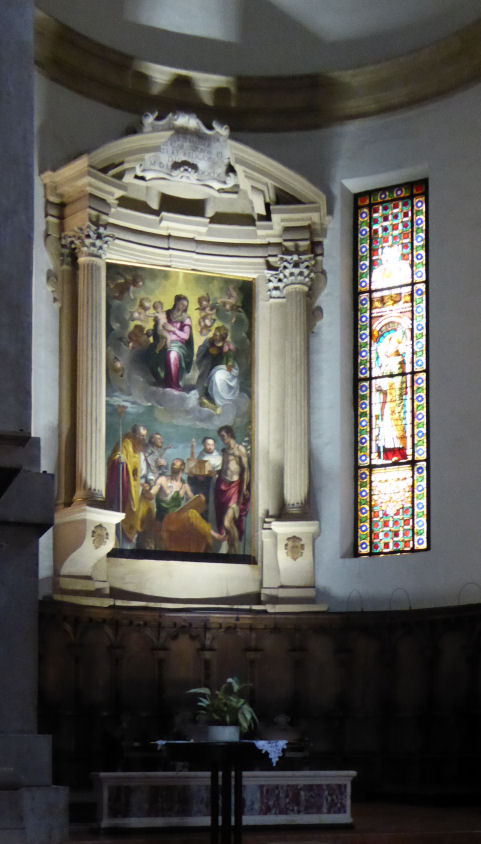 Along the left wall the first and third altars have works by Paolo Farinati, both depicting the Virgin and Child in Glory with Saints - Antonio and Onofrio (1569) in the first, Alberto and Jerome unframed in the third. Between them Saints Peter, John the Baptist and Paul by Torbido (Francesco Moro). The Bonatti organ of 1716 (at the ends of the almost-transept arms) is known to have been played by the 13 year old Mozart, on the 27th of December 1769. In the apse The Virgin in Glory with St Anne, with Saints John the Baptist, Cyril, Thomas Becket and Alberto below of 1579 by Felice Brusasorci (see left). The chapel to the right has a painted wooden crucifix of the 14th century brought here from the suppressed church of Santa Maria della Disciplina (now the Vittoria cinema). The chapel to the left has, in the lunette above the altarpiece, a damaged painting of The Eternal Father by Antonio Balestra. The right wall's second altar (after the tomb of Michele Sanmicheli) has the striking Ecstasy of Mary Magdalene by Alessandro Turchi (Orbetto) of 1604, the third altar has a pretty baroque Annunciation by Ballestra, recently conserved for an exhibition devoted to the artist at the Castelvecchio in 2016/17 to celebrate his 350th. In the the fourth, dedicated to San Rocco, is the highlight Saints Rocco, Sebastian and Job (all looking very classical and muscular) probably painted at the time of the plague of 1510, by Girolamo dai Libri. All the altars are nicely lit. Cloister Through a door in the right aisle is a now-enclosed cloister with frescoed lunettes (see right), by Bernardino Muttoni, the impressive wall tomb of the Grifalconi family and a small sacristy chapel.
Lost art |
|
|

The local guild of cheese makers were
patrons. An altarpiece here is said to show San Mammaso, their
patron saint, sitting in front of the hut in the forest that he was
banished to, surrounded by cheeses, which dairy product he is said to have
invented, but I've never been able to find it. Lost art |
||
|
Quote Opening times A group called Verona Minor
Hierusalem staffs touristic visit times for this church, amongst others.
The times they publicise for this church are
Saturday 10.00 - 5.30 |
|
|
click
here for page 2
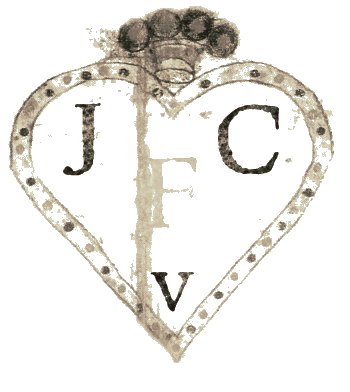
Home
Cannaregio ::
Castello :: Dorsoduro ::
Giudecca :: San Marco ::
San Polo :: Santa Croce ::
The Islands :: Demolished